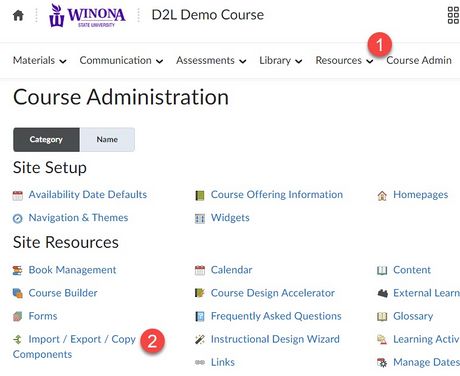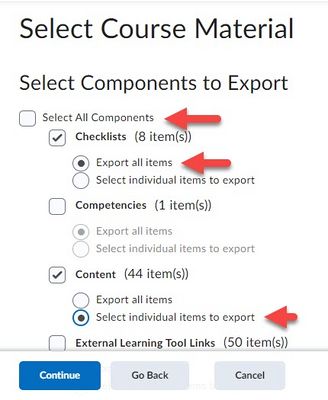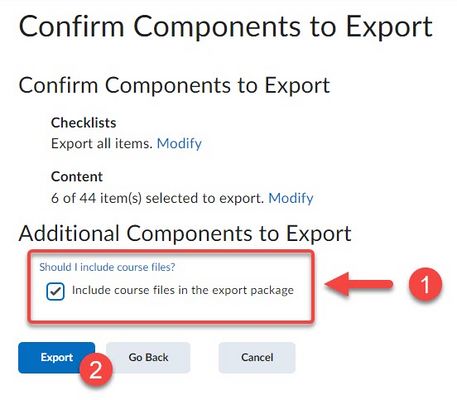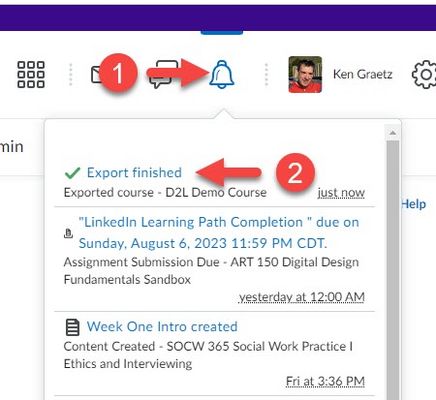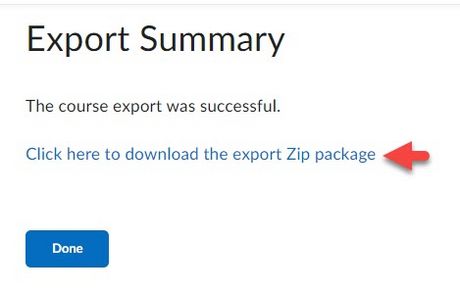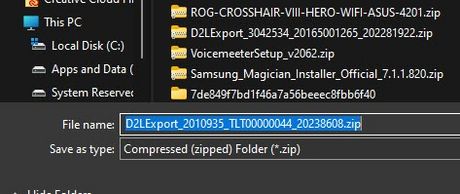Export Brightspace course components
Instructors can export Brightspace course components as a backup and to share with colleagues for importing into their own courses. Export packages are zip files that contain either all or selected course components (e.g., content, quizzes). Packages do not include student data (e.g., class lists, grades, assignment submissions).
Why export
- It's always a good idea to have a backup copy of your Brightspace courses that could be imported if needed.
- Minnesota State maintains the last eight years of courses on our current Brightspace instance. Each semester, they purge courses older than that. Creating export packages is a great way to archive old courses.
- If you want to share components of your course or your entire course with colleagues, giving them the export package is one method. Your colleagues can then import the entire package or selected components into their own Brightspace courses.
- Exported Brightspace course packages do not include private student information and can be shared with others without violating FERPA regulations.
- If you are leaving WSU and need to import your work into another learning management system (LMS), such as Canvas, Moodle, or Blackboard, export packages are a great way to do that.
What's a course package or cartridge
When you export a Brightspace course, it generates a file with a .zip extension that you download and save. This special file type includes many other files zipped up into a single file or package. Sometimes these files are called cartridges (e.g., by textbook publishers). You can then unzip or extract all the files from the package later. Brightspace, and other popular LMSs, include an import function that allows you to extract and upload what you want from the course package into another course. Publishers also use these course packages or cartridges to deliver supplementary materials (e.g., test banks, presentations). They typically email the .zip file or provide a link to it and you import it into your Brightspace course as you would a Brightspace course package.
Create an export package
- Sign in to Brightspace and open the course you want to export.
- Select Course Admin and then select Import/Export/Copy Components (Fig 1).
- Select the Export as Brightspace Package radio button and then select Start (Fig 2). Select Common Cartridge or Thin Common Cartridge if you are interested in importing into another LMS (e.g., Canvas).
- Use the checkboxes to select the course components for export (Fig 3). You can select all components, select all components of a certain type (e.g., all checklists), or select specific items of a certain type (e.g., select some content items and not others). Select Continue.
- If you opted to select specific items of a certain type, you will be asked to select the items, one type at a time (Fig 4). Continue this process for every item type.
- Confirm your selections. Check the Include course files in the export package checkbox if you included Content items in the export package (Fig 5).
- Brightspace will begin building the export package zip file. Select Done to return to your course (Fig 6).
- When the zip file is ready, you will see a new notification in your Update Alerts list. Select that new notification (Fig 7).
- Select the link to the zip file to begin downloading a copy (Fig 8)
- Save the file to your local hard drive or your OneDrive (Fig 9). You can rename the file if you wish, but do not change the file type from .zip.
Pro Tips
- If you don't want to mess with deciding which components to export, check the Select All Components checkbox and save some steps. You probably only need to worry about this if you are sharing your course with someone else, in which case you might want to be more selective.
- You can only export Brightspace courses in which you are listed as the Instructor.
- The export package is a zip file. Once you download it, you can move, copy, and share it as you would any file. It can be imported into another Brightspace course or opened directly (e.g., to extract individual files).
- If you added Kaltura MediaSpace videos to your course, either by embedding them in files you created using the HTML Editor or via the Kaltura Media integration, and you want to include those links in your export package, make sure to select External Learning Tool Links when you select components to export. You can then decide to export all of them or select some.
- Links to integrated textbook resources (e.g., Cengage, Elsevier) and other integrated applications (e.g., Flip, VoiceThread, Tevara) won't function properly when imported into another course. You always want to create these links to third-party integrated applications from scratch each term.
- The default name of the export package is not very readable (e.g., D2LExport_1749836_201210543.zip). It includes the course ID, but not the course name. Either rename the file to something easier to understand (you won't break it) or organize your export packages into folders with the course names and semesters specified. Otherwise, it may be challenging to find the right export package when you want to upload it to a new course later.
- Remember, export packages may include date and time restrictions, hidden modules and content topics, and release conditions tied to the term in which you previously taught the course. These will need to be updated to correspond to the current term after import.
- There are two other ways to share Brightspace course components: via a shared sandbox course and using a shared learning object repository.
More wiki articles
- Import Brightspace course components
- Use Brightspace sandbox courses
- Share Brightspace course components
External links
Except where otherwise noted, text is available under the Creative Commons Attribution-NonCommercial-ShareAlike 4.0 International License.
